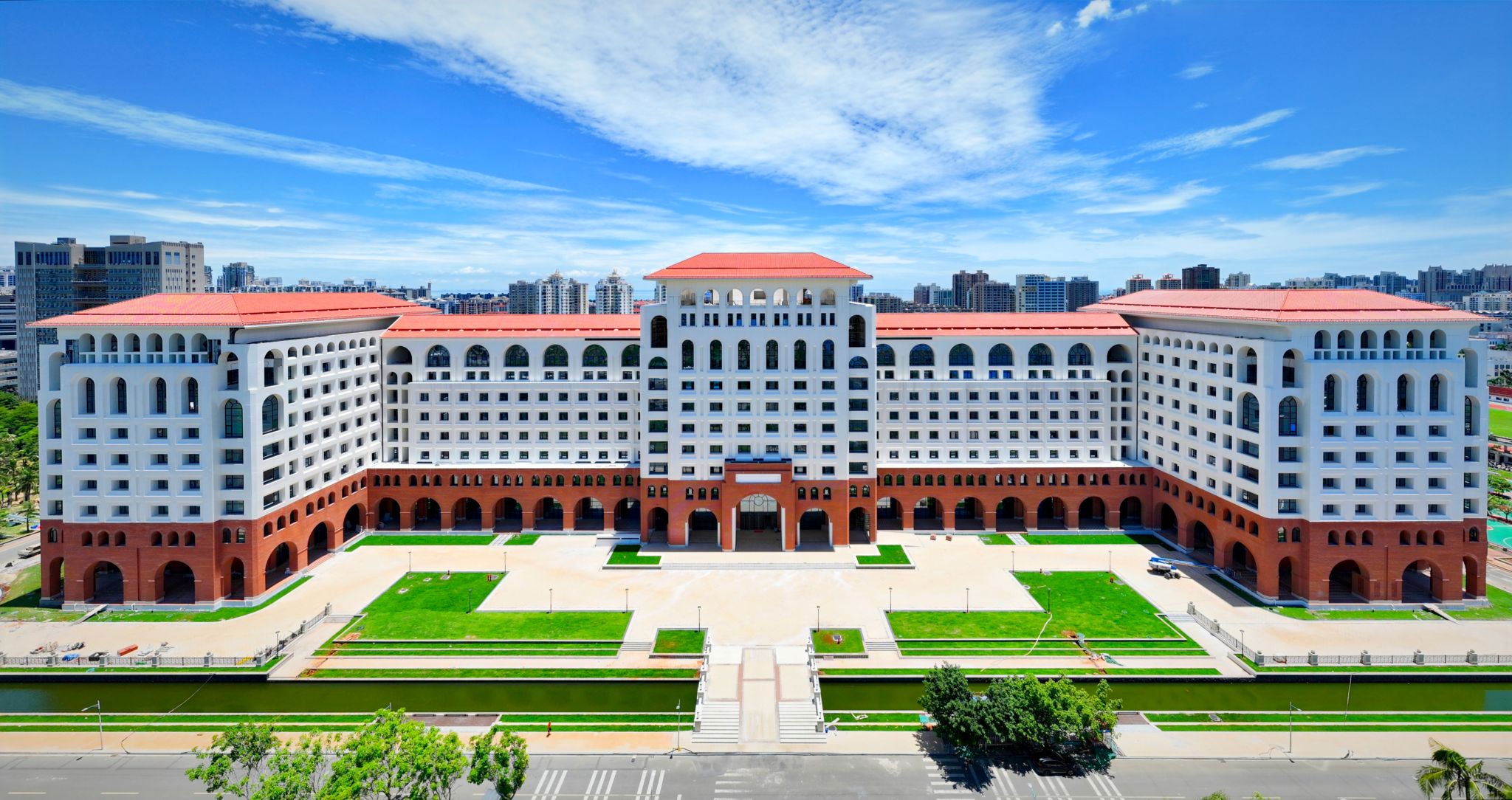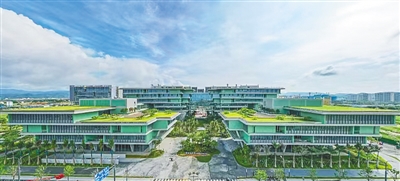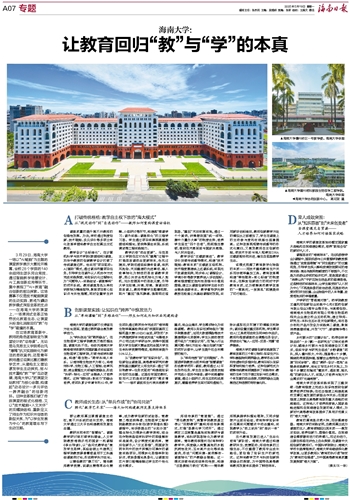On March 29, Hainan University hosted an innovative teaching competition titled “AI in Education”, featuring over 140 faculty-student teams from all 28 schools. The event showcased groundbreaking integration of artificial intelligence in teaching through smart classroom designs and creative applications of AI tools. More than just demonstrating technology-enhanced teaching methods, this competition represents a pivotal shift in educational approaches. Across Hainan University’s classrooms, a quiet revolution is transforming traditional pedagogy: moving beyond standardized formats to restore the fundamental dynamic between teaching and learning.
In this educational transformation, teachers are emerging as “lead designers” of classroom experiences. This shift manifests across diverse teaching scenarios: from the School of Marxism transforming Typhoon Yagi relief efforts into vivid case studies for ideological and political courses, to young faculty honing their pedagogical artistry through teaching competitions; from constructivist approaches that spark student inquiry to AI technologies redefining teacher-student interaction. Through these initiatives, Hainan University has placed “empowering teachers in the classroom” at its core, establishing an innovative cycle of “dynamic design, multidimensional evaluation, and cross-disciplinary integration”. This transformation simultaneously breaks the rigid constraints of traditional instruction while establishing a dual-helix structure of “technological empowerment + humanistic concern”, redefining educators and learners as co-creators of knowledge. The reforms provide living proof of “student-centered development” in practice, where every classroom becomes a dynamic space for intellectual collaboration.

Collaborative Innovation Center of Hainan University. Photo by Gao Kehe
A
Breaking Traditional Constraints: The “Hainan University Model” of Decentralization of Teaching Autonomy
From Prescription to Agency: Teachers’ Reconstruction of Classroom Discourse Power
The improvement of classroom quality relies on the creative contributions of teachers. To this end, Hainan University has implemented a range of comprehensive reforms, including institutional innovation, technological empowerment, and diversified evaluation methods, to restore teachers’ decision-making power over teaching activities.
“De-standardization” of Teaching Design
In the Data Structures class at the School of Computer Science and Technology, Professor Liu Huazhong’s innovative teaching design breaks traditional classroom boundaries. By adopting a “project-driven + AI-assisted” model, he assigns project tasks after class and guides students to engage in practical explorations through human-AI collaboration outside the classroom. This transforms the knowledge internalization process into a closed-loop system of “problem introduction - practical verification - classroom deconstruction”. The teacher’s role shifts from one-way lecturing to targeted guidance, focusing on core knowledge points and common challenges. Interactive elements such as student presentations and group discussions are incorporated, creating a three-dimensional learning environment that integrates “microlecture learning–practical application–course refinement”. This framework enables students not only to master data structure theories but also to develop engineering competencies, particularly in algorithm implementation and system debugging.
“Dynamic Update” of Teaching Content
The School of Marxism pioneered a “dynamic update” model for ideological and political courses while responding to Typhoon Yagi. In the aftermath of the disaster, the school promptly coordinated collaborative lesson planning, transforming heroic deeds and touching stories from disaster resistance and post-disaster reconstruction into vivid teaching resources for ideological and political courses. This conversion of a public safety crisis into an educational opportunity fostered student development by cultivating both cognitive understanding and emotional empathy toward the situation. Through videos and photos, students were taken back to the site of strong winds and floods, gaining first-hand understanding of China’s institutional strengths, particularly in “unified leadership and pooling all resources to accomplish major tasks”. This approach has strengthened students’ “Four-sphere Confidence” —confidence in the path, theory, system, and culture of socialism with Chinese characteristics—while cultivating a sense of solidarity in times of crisis.
“Dual Track” of Technology and Education in Teaching Assessment
Teaching assessment has moved beyond conventional supervision models by establishing a synergistic “technological empowerment– educational principles” framework. In the technological dimension, an online classroom monitoring system has been established for the implementation of non-intrusive classroom observation; meanwhile AI-driven curriculum design and learning analytics have been integrated into the assessment criteria. In the educational dimension, the framework emphasizes three core objectives: fostering critical thinking, shaping values, and tracking progression from teaching innovation to student development. Professor Luo Xianqun, a senior educational supervisor, observed in the general foundation courses that following the implementation of new assessment criteria, teachers increasingly incorporated innovative teaching methods, while students exhibited greater classroom engagement and enhanced perceptions of academic achievement. This reform avoids the formality of conventional supervision, boosts teachers’ motivation for innovation, and creates a self-driven teaching ecosystem by aligning technology with educational principles. The synergy between technological tools and educational principles works in tandem, much like the intertwined structure of a double helix, fostering a self-driven teaching ecosystem.
This model captures the essence of digital transformation in education—restructuring education through technology, rather than simply adding tools. Educational reform should establish a system with an “elastic framework + core standards”, fostering innovation while preserving the essence of education. This approach provides a feasible solution to the common dilemma in higher education reform, where “tight control leads to stagnation and complete freedom results in chaos”.

Teaching Building No. 1, Danzhou Campus, Hainan University (Photo: Hainan University)
B
Innovative Classroom Practice: Revitalizing Knowledge Through “Interdisciplinary” Integration
From “One-way Indoctrination” to “Collaborative Co-creation”: Teacher-Student Knowledge Co-construction
Hainan University’s classroom innovation goes beyond methodological approaches, invigorating teaching through interdisciplinary integration.
From “Disciplinary Isolation” to “Interdisciplinary Integration”
Professor Wan Yi from the School of Biomedical Engineering breaks the traditional academic barriers by leveraging the State Key Laboratory of Marine Resources Utilization in the South China Sea. He has established a “microbial+” interdisciplinary education system that focuses on marine microbial technology and integrates fields like marine science, bioengineering, artificial intelligence, legal risk control, and business management. This system forms a comprehensive talent cultivation model of “research - transformation - application”. This integration of “cutting-edge technology + soft power” has led to numerous achievements, including 63 patent applications. Additionally, his students have earned prestigious awards, such as a gold medal at the International Genetically Engineered Machine (iGEM) competition for their “Nucleic acid tracker: a portable, single base, non-amplification, CRISPR/Cas based nucleic acid testing platform”. They also developed the “Aquaculture Pathogen Rapid Detection Kit”, which improved detection efficiency by more than 50%. This project led to a partnership with Chenhai Aquaculture Company for industry-academia collaboration and earned them the Gold Award at China International College Students’ Innovation Competition (CICSIC) and the Grand Award at China Undergraduate Life Sciences Contest (CULSC).
From “Teacher-Centered Instruction” to “Knowledge Co-Creation”
In the Innovation and Entrepreneurship class, Professor Zhang Lei is redefining the teacher-student relationship by building a knowledge co-creation ecosystem. There are no fixed textbooks; instead, students and teachers work together to identify teaching priorities before class. Industry challenges and student needs are transformed into practical projects. Teachers shift from knowledge disseminators to “scaffold builders”, using technologies like big data models to create modular resource libraries. Meanwhile, students evolve from passive receivers to “solution designers”, gaining the skills needed to solve real-world problems through closed-loop training of “inputting industry challenges–transforming methodologies–outputting innovative solutions”.
From “One-Way Instruction” to “Bi-Directional Empowerment”
Professor Bai Lifang from the School of International Studies has built a “smart classroom” model that forms a teaching loop. Before class, students independently improve language skills using AI tools and prepare for group tasks assigned by the teachers. During class, they engage in group discussions, teacher-student interactions, and presentations, with a focus on improving face-to-face communication skills and bridging the emotional communication gap that is often absent in virtual environments. After class, a dual-reflection mechanism is employed: students evaluate the effectiveness of AI tools and the insights gained from peer collaboration, while teachers adjust tasks based on classroom dynamics, continuously optimizing the “input–application–reflection–improvement” teaching loop.
Hainan University’s classroom innovation demonstrates three core shifts in education: knowledge production transitioning from disciplinary fragmentation to interdisciplinary integration, teaching approaches evolving from one-way delivery to collaborative co-creation, and educational goals shifting from knowledge accumulation to competency development. This innovative paradigm offers a blueprint for addressing the challenges in traditional education. The vitality of education lies in establishing a dynamic connection between knowledge, societal needs, and individual development, with interdisciplinary integration acting as the catalyst for building this connection.

School of Biomedical Engineering, Yazhou Bay Science and Education Park, Hainan University. (Photo: Hainan University)
C
Ecosystem for Teacher Growth: From “Solo Efforts” to “Collaborative Advancement”
Cultivating “Teaching Artists”: Teacher Development Ecosystem
Empowering teachers to take full initiative of the classroom requires systematic growth support. Hainan University has established an ecosystem for teacher development through three core platforms.
The “Wisdom Hub” of Teaching-Research Communities
The seminar courses exemplify how innovative pedagogy can be implemented across disciplines. In the national first-class course Introduction to Li Bai, Professor Haibin from the School of Humanities demonstrates the “inquiry-based pedagogy” to ignite students’ critical thinking. His approach has been adapted by Professor Xue Chunxia from the School of Civil Engineering and Architecture for case discussions in basic engineering courses, demonstrating the adaptability of pedagogical innovation across academic domains.
The “Forge” of Competition-Driven Teaching
Regular competitions such as the Young Teachers’ Competition and Lesson Planning Competition serve as testing grounds for pedagogical innovation. Associate Professor Yu Lejun from the School of Biomedical Engineering, a second-prize winner of the Young Teachers’ Competition was inspired by the “cognitive stratification” concept proposed by judges. He transformed it into a modular teaching framework for his course Digital Image Processing. By integrating real-world image analysis cases from crop phenomics research, he designed a tiered case library. The interaction with the judges in the competition encouraged him to stratify technologies from national invention patents into practical teaching modules. Using modules to organize knowledge points, he transformed abstract theories into tangible applications. This approach ensures the precise adaptability of his instruction to students’ personalized growth needs, functioning much like a chip interface.
The “Blue-Green Chain” of Mentorship Legacy
Through the “Lead Professor System”, Professor Nie Lixiao from the Nanfan School has reimagined mentorship through “field-based teaching and research”, creating a “scenario-based learning loop”. By linking on-site investigations at Sanya’s Nanfan bases with classroom instruction, he has transformed research sites into teaching resource libraries. Inspired by his approach, young Teacher Li Yaxin has deeply integrated practical cases from Nanfan bases into her teaching of Breeding Science, such as rice disease resistance research and corn yield optimization, forming an industry-education integration chain of “problem identification, case analysis and classroom application”. This model transcends traditional one-way mentorship, establishing a “dual-scenario capability leap” mechanism. Young teachers not only inherit disciplinary frameworks but also upgrade them with cutting-edge industrial insights, dynamically reconstructing the breeding science knowledge system around real-world challenges. As a result, the teaching evolves from “theoretical discourse” to “practice-integrated training”.
The development of contemporary education has entered a new stage of “ecological cultivation”. By constructing a three-dimensional ecosystem integrating teaching-research symbiosis, competition-driven innovation, and mentorship inheritance, Hainan University has not only reshaped the professional growth path of teachers but also created a new paradigm for knowledge production. This exploration of deep integration between teaching art and technological innovation provides a vivid model for the development system of teachers in higher education with Chinese characteristics.
D
Breaking Through in Educational Outcomes: From “Knowledge Containers” to “Future Innovators”
When Classrooms Encounter the Free Trade Port: Aligning Talent Cultivation with National Strategies
Hainan University’s classroom teaching reforms have always focused on major national strategies and the needs of the Free Trade Port (FTP) construction, cultivating the new-era talent who are “daring to pioneer and capable of innovation”.
The “Hainan Model” of Moral Education
In the course Tourism Hospitality, Professor Guo Qiang from the School of International Tourism and Public Administration guides students to deeply analyze Hainan’s measures during the pandemic through the dual perspectives of a “policy microscope” and a “people’s livelihood thermometer”. The continuous increase in off-island duty-free shopping quotas is not only an economic lever to support the tourism industry but also a thoughtful approach from the state to safeguard people’s quality of life through “consumer benefits”. These vivid cases enable students to realize that “people-centered governance” is no longer an abstract political concept; it is reflected in the focus on people’s livelihood in government decision-making, humanistic considerations in corporate transformation, and increased happiness following policy implementation.
Zero-Distance Docking of Industry-University-Research Collaboration
Professor Wang Xin from the School of Pharmaceutical Sciences has established university-enterprise interaction mechanisms with biomedical-related enterprises such as GAORONG VENTURES and Hainan Haiyan Biomedical Co., Ltd. through platforms like the Innovation and Entrepreneurship Practice Center and the micro-major program Medical Innovation and Top Entrepreneurship. By adopting an innovative mentorship model that integrates mentors, graduate students, and undergraduates, the team incorporates market analysis and product development as key components of its practical curriculum. Focusing on the consumer health sector, the team has successfully developed five products, including “Dingning” and a soothing essence.
The “Double One Initiative” for Rural Revitalization
The School of Tropical Agriculture and Forestry has launched the “One Township (Town), One Graduate Student” targeted cultivation program. Aiming at the intersecting needs of rural revitalization and FTP construction, it organizes expert-graduate student teams called “Rural Classrooms”. These teams conduct “field diagnostics” in eight townships, including Nada, Zhonghe, and Yaxing in Danzhou, focusing on characteristic industries such as tropical fruit and vegetable cultivation and smart agriculture. Through full-chain practical teaching of “investigation - design - implementation”, students’ research is applied to rural development. This model provides agricultural science talent that is “technology-savvy, policy-adept, and locally-rooted” for each township, achieving a “seamless integration” between talent cultivation and local industrial needs.
Hainan University’s reform practices have achieved threefold breakthroughs: transforming from knowledge transmission to innovative cultivation in the educational dimension; establishing a new model of university-local cooperation that supports regional development in the social dimension; and exploring implementation pathways for higher education to serve major national strategies in the national dimension. This talent cultivation model, deeply embedded in national strategic processes and the development of the Free Trade Port, provides a demonstrative “Hainan University Solution” for higher education reform in the new era.
The essence of education lies in igniting students’ curiosity, not filling them as containers. Hainan University’s practice has proven that when teachers truly become the masters of the classroom, education can return to its core: stimulating intellectual curiosity, cultivating innovation, and shaping values. The Free Trade Port construction requires the most dynamic trailblazers, and this vitality originates from teachers who freely explore on the podium and boldly innovate in the classroom. Luo Qingming, Member of the Chinese Academy of Sciences and President of Hainan University, states that the university will continue to deepen teaching reforms, enabling more teachers to transform from “implementers of education” to “creators of education”, and strive to explore the “Hainan University Solution” for the high-quality development of Chinese higher education.

Translated by Zhao Shanshan; Sun Chengping
Proofread by Bai Lifang